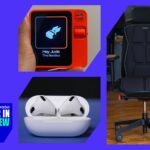The dawn of annoyingly massive satellites is upon us, shielding our views of the shimmering cosmos. Five of the largest communication satellites just unfolded in Earth orbit, and this is only the beginning of a Texas startup’s constellation of cellphone towers in space.
AST SpaceMobile announced today that its first five satellites, BlueBirds 1 to 5, unfolded to their full size in space. Each satellite unfurled the largest ever commercial communications array to be deployed in low Earth orbit, stretching across 693 square feet (64 square meters) when unfolded. That’s bad news for astronomers as the massive arrays outshine most objects in the night sky, obstructing observations of the universe around us.
Things are just getting started for AST SpaceMobile, however, as the company seeks to create the first space-based cellular broadband network directly accessible by cell phones. “The deployment of our first five BlueBird commercial satellites marks just the beginning of our journey,” Abel Avellan, founder and CEO of AST SpaceMobile, said in a statement. “Our team is already hard at work building the next generation of satellites, which will offer ten times the capacity of our current BlueBirds, further transforming mobile connectivity and delivering even greater benefits to our customers and partners worldwide.”
In September 2023, the Texas-based company made the first ever 5G phone call between its prototype satellite and a Samsung Galaxy S22. The satellite’s arrays connect directly to standard smartphones at broadband speeds, but that innovation comes at a price.
The company’s prototype satellite unfurled its giant array in late 2022, outshining most objects in the skies except for the Moon, Venus, Jupiter, and seven of the brightest stars. BlueWalker 3 appeared as bright as two of the ten brightest stars in the night sky, Procyon and Achernar, through the lenses of different telescopes, according to a Nature study published in October 2023. Before unfurling its array, the satellite had a brightness magnitude of around +3.5, making it visible to the naked eye. However, after deploying its antenna array, its brightness increased by about two magnitudes.
Unfortunately, now there’s five more of them. AST SpaceMobile launched its five BlueBird satellites on September 12, seeking to build a constellation of more than 100 satellites in low Earth orbit to provide nationwide coverage across the U.S.
The latest constellation is an indication of an increasingly worrying problem that’s suffocating Earth orbit, with the number of large satellites increasing five times over the past 12 years, according to a letter sent by a group of space experts to the Federal Communications Commission (FCC).
“Experts from top universities are warning we’re in a short window of time when we can prevent making a mess of space and our atmosphere rather than spend decades cleaning it up,” Lucas Gutterman, director of the U.S. PIRG Education Fund’s Designed to Last Campaign, said in the letter. “The new space race doesn’t need to create massive space waste.”
The letter calls on the FCC to follow the recommendations of the U.S. Government Accountability Office and stop excluding satellites from environmental reviews. AST SpaceMobile isn’t the only company trying to build cellular towers in space. SpaceX is building its own constellation of satellites, with more than 6,000 Starlink satellites currently in low Earth orbit. Amazon, OneWeb, and Lynk Global are other companies trying to get in on the action.
Those satellites, however, have a major impact that can’t be ignored. “Artificial satellites, even those invisible to the naked eye, can obstruct astronomical observations that help detect asteroids and understand our place in the universe,” Robert McMillan, an astronomy professor and founder of the Spacewatch Project at the University of Arizona, said in the letter.
The letter continues, “This is a new frontier, and we should save ourselves a lot of trouble by making sure we move forward in a way that doesn’t cause major problems for our future.”
Read the full article here











